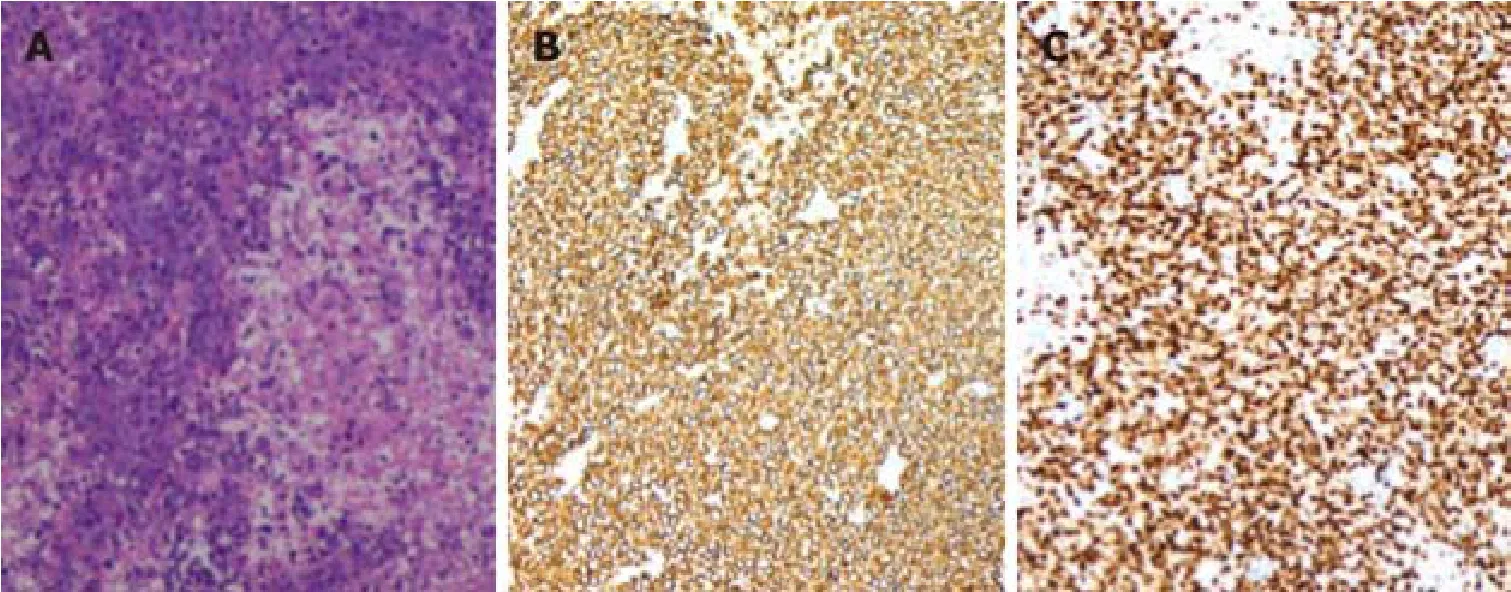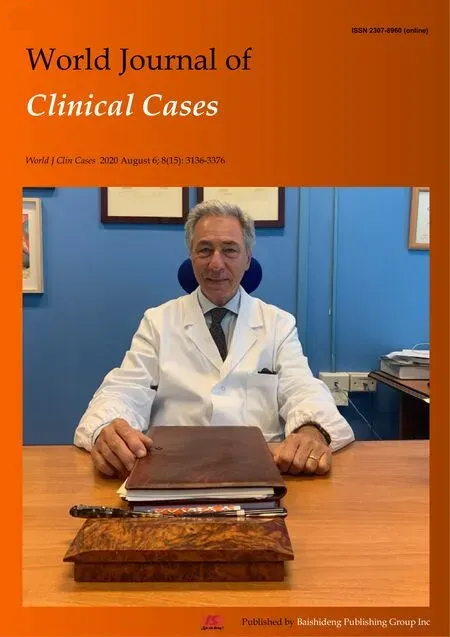Imaging of hemorrhagic primary central nervous system lymphoma:A case report
Ya-Wei Wu, Jin Zheng, Lu-Lu Liu, Jun-Hui Cai, Hu Yuan, Jing Ye
Ya-Wei Wu, Jin Zheng, Lu-Lu Liu, Jun-Hui Cai, Hu Yuan, Jing Ye, Department of Radiology,Clinical Medical College of Yangzhou University, Northern Jiangsu People's Hospital,Yangzhou 225001, Jiangsu Province, China
Abstract
Key words:Primary central nervous system lymphoma;Massive hemorrhage;Perfusion;Multimodal magnetic resonance imaging;Lymphoma;Case report
INTRODUCTION
Primary central nervous system lymphoma (PCNSL) is a relatively rare tumor that accounts for approximately 2%-6% of all primary brain tumors.The majority of intracerebral lymphomas are non-Hodgkin’s lymphomas, and approximately 90% are diffuse large B-cell lymphomas[1,2].PCNSL is less common in immunocompetent individuals.However, due to the increasing prevalence of human immunodeficiency virus infection and the growing number of organ transplantations, the incidence of PCNSL has been increasingly observed in both immunocompromised patients and the immunocompetent population over the last decades[3].Mild to moderate edema and space-occupying effects can always be seen in PCNSL[4], but massive hemorrhage at presentation in PCNSL is extremely rare.The presence of hemorrhage is utilized to exclude primary cerebral lymphoma in the differential diagnosis[5].
The clinical treatment for PCNSLs is different from that of other tumors, and an early and accurate diagnosis is vital to improve the treatment outcomes.Herein, we present a particular case of PCNSL with multimodal magnetic resonance imaging(MRI) examinations.The purpose of this study was to provide insight into some MRI characteristics of hemorrhagic lymphomas and to facilitate the differentiation between PCNSLs and other brain tumors.
CASE PRESENTATION
Chief complaints
A 48-year-old man was admitted to a local hospital with a 10 d history of headache and dizziness, followed by aggravation of these symptoms for 2 d.
History of present illness
None.
History of past illness
The patient was previously in good condition and had no history of congenital or acquired immunodeficiency.
Laboratory examinations
A series of routine examinations before the surgical operation were unremarkable,including:(1) Routine blood testing of serum levels of platelet, alpha fetoprotein,Carcinoembryonic antigen, CA199, neuron-specific enolase and progastrin releasing peptide;and (2) Cerebrospinal fluid analysis.
Imaging examinations
Non-contrast-enhanced computed tomography (CT) examination was performed immediately after admission, and a round and high-density lesion approximately 56 mm × 46 mm in size was found in the right temporal lobe surrounded by moderate edema (Figure 1A).It compressed the right basal ganglia and the right lateral ventricle,forcing a midline shift towards the left.For further diagnosis, CT angiography examination was performed, and the possibilities of vascular malformation and aneurysms were excluded.Multimodal MRI examinations of the brain were conducted on the same day.The gross appearance of the lesion was heterogeneous on MR images.The parenchyma of the lesion showed iso- to hypointensity on T1-weighted(T1W) and T2-weighted images, which can be interpreted as a relatively hyperintense signal on diffusion-weighted images (DWI).Contrast-enhanced T1W images showed the lesion with ring-like enhancement.The gross lesion displayed relatively low perfusion on arterial spin labeling (ASL) images (Figure 1).
FINAL DIAGNOSIS
According to the radiological findings, the initial imaging impression was glioblastoma combined with hemorrhage.Surgery was performed 3 d after admission to the hospital.The lesion was completely resected, and the hematoma (approximately 30 mL) was also removed.The parenchyma of the lesion was 30 mm × 25 mm × 20 mm in size;it looked like rotten fish, was yellow-gray in color and accompanied by some blood vessels.
Histopathological examination revealed that the nuclei of the tumor cells were round or elliptic, with prominent nucleoli, diffuse arrangement and necrotic tissue formed in the lesion.In the immunohistochemical stains, cells were positive for B-cell markers (CD20 and Pax-5;Figure 2), and the Ki-67 index was 70%.The lesion was identified as a diffuse large B-cell lymphoma with acute hemorrhage.
TREATMENT
The lesion was completely resected.
OUTCOME AND FOLLOW-UP
The patient was treated with chemotherapy following surgery.He had no imaging findings of recurrence at 6 and 12 mo after treatment.
DISCUSSION
Even though PCNSLs are relatively rare, and represent 1%-2% of all primary CNS malignancies, their incidence has risen over recent years[3].In immunocompetent populations, the median age of PCNSL occurrence is 53–years-old to 57-years-old,with a male to female ratio of 1.5:1[6].PCNSLs can occur in the brain parenchyma,meninges, eyes or spinal cord.Approximately 70% are restricted to the supratentorial brain[2].The most common presentation of a PCNSL is a single intracranial mass.The clinical manifestations of PCNSLs are similar to those of other intracranial tumors,including high intracranial pressure and focal neurological deficits.To date, six cases of lymphoma with hemorrhage have been reported.Massive bleeding hemorrhage at the first presentation of lymphoma has been reported in only three cases thus far, and this is the only case with detailed structural and perfusion MRI examinations.
In this case, the structural MR images revealed that the parenchyma of the lesion was consistent with a previous study on PCNSLs.PCNSLs always present with a defined margin and are surrounded by mild to moderate edema[2,7].They appear as homogeneous, iso- to high-density lesions on CT images and as iso- to hypointense lesions relative to the gray matter in T1W and T2-weighted images due to the hypercellularity of the lymphomatous deposits.Approximately 85% of lesions exhibit homogeneous enhancement both on CT and MRI following contrast administration[8].Ring-like enhancement is rarely seen unless necrosis occurs in the center of the mass,which can always be seen in acquired immunodeficiency syndrome-related PCNSLs[1,2].On perfusion images, the lesions show relatively lower perfusion as a whole.The proliferation pattern of lymphomas includes vasocentric growth, and vessels in lymphomas are few and small.Compared with the fulminant neovascularization of glioblastomas, the blood flow of PCNSLs is relatively lower[9].

Figure 2 Histological examination and immunohistochemical analysis of the lesion.
Recently, some advanced imaging techniques, such as ASL perfusion imaging and DWI, which respectively reflect tumor vascularity and cellularity, have been successfully applied for the differential diagnosis between lymphomas and other brain tumors[10].The majority of PCNSLs demonstrate relatively lower perfusion in ASL images and higher intensity on DWI images than other brain tumors[7,11], which is consistent with our findings.As previous studies have shown, ASL and DWI are potential diagnostic tools for differentiating PCNSL from glioblastoma due to their differing hemodynamics and tumor density[12,13].
Hemorrhage is very rarely observed in untreated CNS lymphoma[4].The mechanism of the occurrence of primary lymphoma with hemorrhage remains unclear, and it could be potentially explained by high immunoreactivity for a vascular endothelial growth factor may account for it[5,14,15].Another explanation is that fragile vessels traversing necrotic areas or tumor invasion of large vessels lead to the breakdown of the vessel wall, resulting in bleeding[16].
CONCLUSION
Accurate diagnosis of lymphoma is essential in clinical practice and is related to therapeutic decision-making and the patients’ prognosis, whereas the diagnosis of atypical PCNSLs is difficult.We presented a special case of a PCNSL with acute massive hemorrhage.The case provided detailed information on CT and MRI examinations for reference, which may be useful for the differentiation between PCNSLs and other brain tumors.
 World Journal of Clinical Cases2020年15期
World Journal of Clinical Cases2020年15期
- World Journal of Clinical Cases的其它文章
- Facial and bilateral lower extremity edema due to drug-drug interactions in a patient with hepatitis C virus infection and benign prostate hypertrophy:A case report
- Total laparoscopic segmental gastrectomy for gastrointestinal stromal tumors:A case report
- COVID-19 with asthma:A case report
- Computed tomography, magnetic resonance imaging, and Fdeoxyglucose positron emission computed tomography/computed tomography findings of alveolar soft part sarcoma with calcification in the thigh:A case report
- Acute suppurative oesophagitis with fever and cough:A case report
- Coexistence of ovarian serous papillary cystadenofibroma and type A insulin resistance syndrome in a 14-year-old girl:A case report
